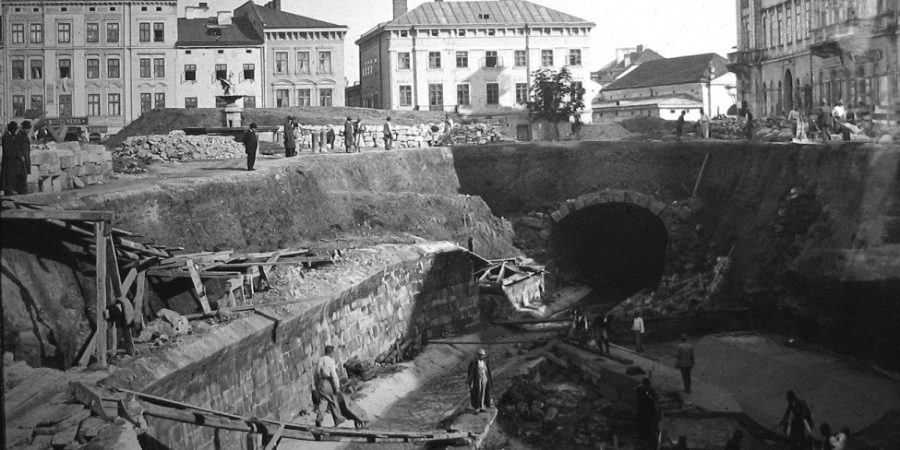By Chris Wilkinson
The old city center of Lviv seems to have it all. Medieval and Baroque architectural wonders, a magnificent Neo-Renaissance opera house, cobblestone streets, fashionable coffee houses and eye popping, colorful buildings. This ensemble was deemed worthy of UNESCO World Heritage Site status. The cliché that you have to see it to believe it holds true for this marvelous city. The beauty, romance and delicious architecture also serves as a distraction. It keeps visitors from noticing the one thing that is actually missing in Lviv, flowing water. Search all over Lviv, but a river or a creek will not be found. This is quite strange, since the landscape surrounding the city is lush. A climb up Zamkova Hora (High Castle Hill), the city’s highest point offers a commanding view over the city, but no water source can be spied from this prominence. Where is the stream which quenches the city and the surrounding landscapes thirst?

The River That Gave Life To Lviv
A surface glance demonstrates that Lviv is an outlier among central and western Ukrainian cities when it comes to waterways. Kyiv, Dnipropretrovsk and Zaporizhia were built up along the Dnipro River. Smaller cities like Chernivtsi and Ivano-Frankivsk are set on banks of the Prut and Bystrytsia Rivers. It is fascinating to imagine how Lviv could have grown to such size and stature without being on or near a river. Such a leap of imagination is not required, because Lviv is set on a river, one that is now buried just beneath the city. The Poltva River can neither be seen nor heard along the streets and squares of Lviv’s old town. There is no trace of its existence. This is deceptive because the river is still an important part of the city today, just as it has been since Lviv’s founding in the thirteenth century.
Medieval Lviv grew up along the banks of the Poltva, a short yet important river in western Ukraine. While the Poltva is a mere 60 kilometers in length, it drains over 200 creeks and streams before entering the western Bug River. It is hard to imagine the modern urban environment of Lviv once had a river flowing through the middle of it. The river was a lifeline for security, commerce and trade. The Poltva delineated the northern boundary of the city, its waters creating a natural moat. Ships would ply the river while bringing loads of goods from as far away as the Baltic Sea. Mills once lined the river banks. Conversely, the Poltva brought many natural, but undesirable things to the city in the form of disease. Its murky waters were a breeding ground for pestilence. Swarms of mosquitoes and flies were often accompanied by an unbearable stench. The fetid waters caused mildew and rot.

The Lifeblood Of A City Goes Underground – Burying The Poltva
By the nineteenth century Lviv was a fast growing hub city for the eastern fringes of the Habsburg Empire. As the city began to modernize, officials decided that something needed to be done with the Poltva. It had long caused public health problems, such as outbreaks of malaria. It was thus decided to encase and cover over the Poltva, routing the river through the city sewer system. By 1870, fifteen kilometers of the river flowing through the main part of the city had been covered. Despite World War, revolution and the city falling under the rule of multiple empires and nations, work on covering the Poltva proceeded apace. Just before the turn of the twentieth century designs were vetted for a grand opera house in Lviv. Due to space concerns in the inner city it seemed all but impossible to locate the building in that area. The buildings designer, Zygmunt Gorgolewski, struck upon a novel idea. In his proposal, the Opera House would be located where the Poltva flowed, but the river would be covered over. The building would have a concrete rather than earthen foundation, which would allow the necessary stability.

Gorgolewski’s idea was a stunning success. In 1900 the magnificent new Grand Theater (known today as the Lviv Theatre of Opera And Ballet) was opened. There were reports that the building sunk in the years that followed its opening, but finally stabilized. Local legend says that the Poltva can be heard flowing from the orchestra pit of the opera house. The covering of the river throughout the greater Lviv area continued in the decades that followed. By the outbreak of the Second World War, 150 kilometers of the Poltva had been covered. Famously, the Poltva tunnels became a hiding place for a handful of Jews who had escaped the Nazis during the war. They survived by hiding in these tunnels and through the efforts of two Polish sewer maintenance workers Leopold Socha and Szczepek Wróblewski. The 2011 award winning film, In Darkness, by the Polish director Agnieska Holland was an award winning recreation about this story of survival in Lviv’s sewers. After the war ended work on covering the Poltva was renewed. By the end of the 20th century the river was completely covered throughout nearly all of the Lviv area.

An Invisible Presence
The Poltva River is now underground, an invisible presence in the life of the city. Modernity demanded that the river be subdued. Technology and the minds of man completed the process. What once gave life to Lviv has been reduced to a collection point for rainwater and sewage flowing through a labyrinth of tunnels. The river still exists, only now it is out of sight and out of mind. Imperceptible in the consciousness of the city it helped create.
Source: Europe Between East and West






[…] Läs om Lvivs underjordiska flod! Lviv’s Underground River: The Poltva – Forgotten GaliciaLviv’s Underground River: The Poltva March 15, 2018 By Chris Wilkinson The old city center of Lviv… […]